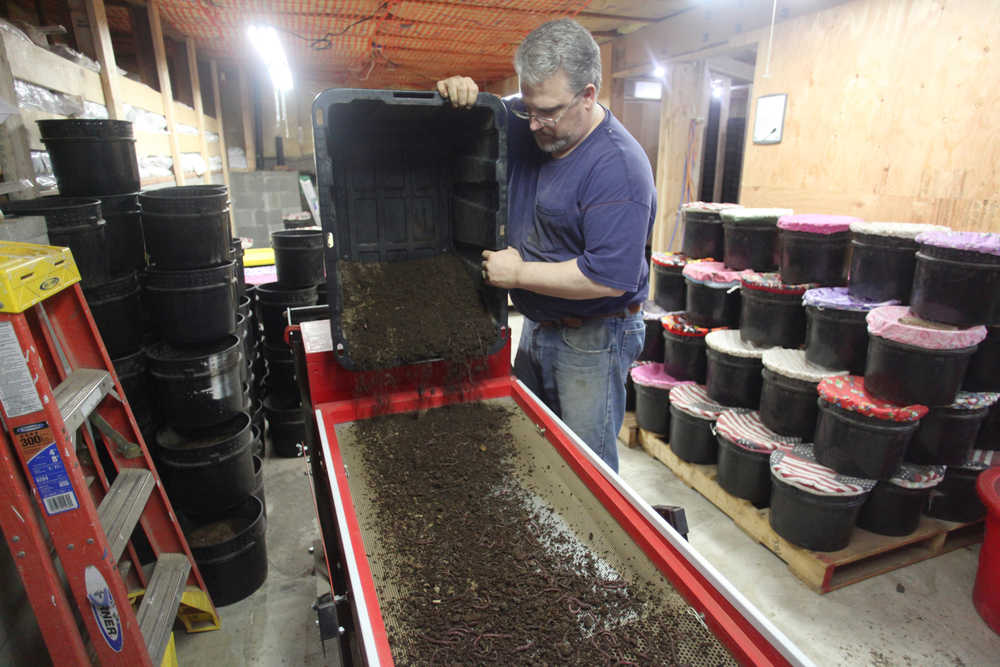A Kasilof local has found a way to address difficulties crops have accessing existing nitrogen in Alaska’s soils, and to infuse additional, essential nutrients into arable land.
Michael Hicks, co-owner of Grandpa’s Worm Castings, has been refining his worm poop production process for nearly two decades, a product he says is an effective method for improving soil composition. He presented on his operation Tuesday, April 12 at the most recent Central Peninsula Garden Club meeting.
Castings, or worm excreta, contain microbes that break down nitrogen to the molecular level where plants can use it to create chlorophyll, which is essential for photosynthesis.
Heat and chemicals can perform the same process, Hicks said, but will not eliminate pathogens such salmonella or E. Coli, which can be found in composts containing human or animal waste. Alaska’s soils contain plenty of nitrogen, but because of the dense topsoil and cold ground temperatures, it is hard for vegetation to properly absorb it, he said.
Castings also loosen tough ground, eliminate other odors, are odorless themselves, and are an organic fertilizer, Hicks said.
“If you got worm castings, you weren’t feeding them chemicals,” Hicks said.
Chemicals are just one of the many ways to kill worms.
The creatures are surprisingly temperamental as Melodie Hicks, Hicks’ wife and co-owner of Grandpa’s, found out when she and her husband first started sinking their hands into planning and production nearly six years ago. She said she experienced some hesitation when he first came to her with the idea, inspired by their daughter, but her fear quickly passed when she realized, “okay, worms aren’t going to crawl up my stairs or come into my house or anything like that.”
The Hicks’ bought the worm farming methods from UNCO Industries Inc., which is a vermiculture — the process of raising worms to harvest their droppings to use for fertilizer — company based out of Wisconsin, and is one of only about four large-scale operations in the U.S. There are few vermiculture operations working at any scale Alaska, and so much of what the couple accomplished has been through their own process of trial an error, which lasted about three years.
One of the biggest issues the couple ran into was keeping the worms warm, Melodie Hicks said. They keep their indoor dirt pit, and buckets of nightcrawlers creating the worm castings, at a constant 70 degrees Fahrenheit, she said. Worms will not survive a freeze, although their eggs can, Michael Hicks said.
The cost of heating worms was the factor most likely to keep the business from getting off the ground, Michael Hicks said. It took years to figure out how to heat the huge piles of peat needed to keep their stock alive through winter, and be able to make a profit, he said.
Worms need fresh bedding, or peat mixed with feed, every two weeks to survive. The process of switching out what are buckets of roughly 80 percent worm castings with new bedding is called “turning.”
It takes about 16 hours a week for Michael Hicks and his wife to turn all their worms, which are kept in what was once the crawl space, now a basement, of their Kasilof home. Protein poisoning, an unbalanced pH — or acidity levels — lack of moisture, gas production and inadequate food supply are a few of the main ways the Hicks’ found will quickly deplete their supply of small, slimy workers.
“As a kid, I only knew of one good way — drowning,” Michael Hicks said. “And I drowned a lot of worms. However, in raising worms in captivity I have found many.”
These are all issues unique to worms bred in captivity, he said.
“They become serious problems when they are unable to freely move out of an unhealthy environment unbeknownst to the vermiculturist,” he said.
Many farmers and gardeners on the Kenai Peninsula are using the product on their land, said Casey Matney, a horticulture agent for the Kenai Peninsula’s University of Alaska Fairbanks Cooperative Extension Service.
“Many of our natural soils do not have sufficient nutrients for optimum crop growth, and so most of our soils are amended in one way or another,” Matney said. “Adding organic matter and compost to soils will improve growing conditions for plants.”
Worms accelerate the natural “weathering and feeding” of microorganisms in soil that break down materials plants need for growing, Matney said. Worm compost contains roughly 50 percent organic matter, he said.
“Worms consume and digest relatively high carbon feed as well as other more nutritious materials (food waste and compost type items),” Matney said. “Through their castings they leave behind fertile processed materials that can improve soil for plants.”
The Hicks’ are producing roughly 40 cubic yards, or 27 tons of worm poop annually.
“This was not a must-happen for me,” Michael Hicks said. “As I read and learned more about it, I became more confidant, and eventually stepped out.”
Their sales range stretches from gardeners to commercial retailers in Seldovia to Seward, and eventually they plan to expand to Anchorage, and saturate the rest of the state, Michael Hicks said.
While there is not a bounty of earthworms in Alaska, which are believed to have been mostly wiped out by the last ice age, there are a few, and the two varieties the Hicks’ use in their operation are pulled from local soils.
“I have since seen and identified these same varieties in Kenai and Kasilof in rain puddles and on sidewalks in late July and August on rainy days,” Michael Hicks said. “Maybe they have always been there and I just never noticed … But I do notice now.”
Reach Kelly Sullivan kelly.sullivan@peninsulaclarion.com.

